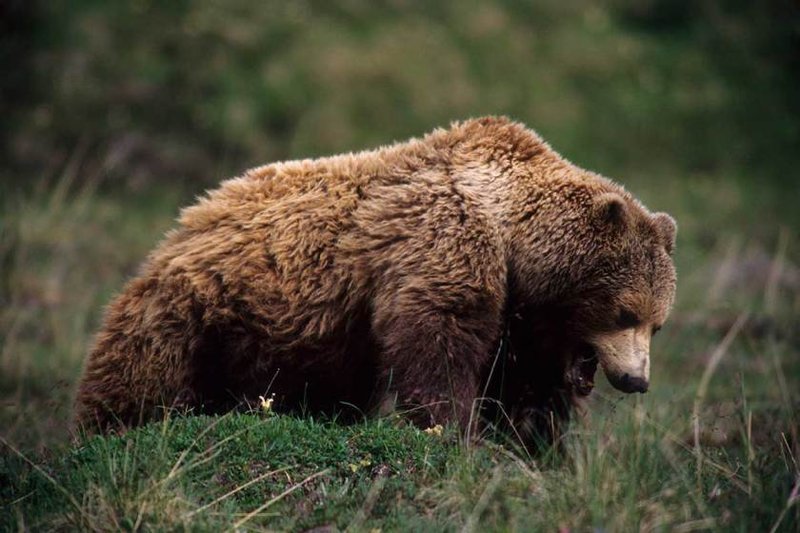
Imagine you’re on a hiking trail, the sun shining down, when suddenly, you spot a massive creature lumbering through the trees. Your heart starts to race, and panic might set in. But here’s the thing: staying calm and knowing your next steps are crucial. Let me explain what to do if you ever find yourself face-to-face with a grizzly bear in the wild.
Understanding Grizzly Bear Behavior
To navigate a bear encounter, it’s helpful to understand how grizzly bears typically behave. Grizzlies are wild animals, and their actions can vary based on the situation. They are generally solitary creatures but can be very protective of their territory, especially if they feel threatened or if they have cubs nearby.
Grizzly bears can show different behaviors—some may appear curious, while others may exhibit signs of aggression. You might be wondering, how do I tell the difference? Look for cues like vocalizations (grunting or huffing), body language (hunched posture might signal aggression), and whether the bear is making eye contact. Observing these behaviors can help you gauge the bear’s mood.
Remember, if a bear is foraging or seemingly unaware of your presence, it’s often best to give it space and back away slowly. Grizzly bears can run much faster than humans and have a strong sense of smell, so it’s important to approach the situation with caution.
Stay Calm and Assess Your Surroundings
If you find yourself in a situation where you encounter a grizzly bear, the first step is to stay calm. I know, easier said than done, right? But panicking can lead to poor decisions. Take a moment to assess your surroundings. Is there a clear path to backtrack? Are there trees or rocks that might provide cover?
Stand still and keep your bear spray handy. Yes, that’s right! Bear spray can be a game-changer. It’s like a security blanket in the wild, ready to defend you if needed. You might think, “Will I really know how to use it?” Don’t worry! Using bear spray is straightforward. Just aim for the bear’s face and spray in short bursts if it charges.
Taking stock of your environment also helps keep you grounded. It can be easy to feel overwhelmed, but focusing on your immediate surroundings can help calm your nerves.
Make Your Presence Known
Bears are often as curious about us as we are about them. Making your presence known can help avoid surprises. Talk loudly and calmly to the bear. Avoid yelling or making high-pitched sounds, as these can sound like a threat. You’re not performing a one-man show; you’re simply letting the bear know you’re there.
You might also want to gently wave your arms. This action can help the bear recognize you as a human and not some other animal. If you’re in a group, stay together. There’s strength in numbers!
Sometimes, bears are just as curious about you as you are about them. They want to know whether you pose a threat or not. By showing you’re human, you might just encourage them to take their curiosity elsewhere.
Backing Away Slowly
If the bear doesn’t seem aggressive and is just minding its own business, it’s best to back away slowly. Think of it like a dance—no sudden moves! Keep your eyes on the bear but avoid direct eye contact, as this can be perceived as a challenge.
While backing away, don’t turn your back on the bear. Keep your body facing it. This way, you can react quickly if it decides to charge. When you’re moving away, make sure your path is clear—no branches or rocks that could trip you up. Keep an eye on the ground while also monitoring the bear.
Backing away gives the bear space, which is what it often wants. Remember, this is their home, and you’re just a visitor disturbing their peace. Being respectful and cautious can lead to a safer outcome.
What to Do If a Bear Charges
Now, let’s discuss the elephant in the room—or rather, the bear in the woods. If a bear charges, your first instinct might be to run. But here’s a crucial piece of advice: don’t run! Bears can reach speeds of up to 35 miles per hour. Trust me; you won’t win that race.
Instead, stand your ground. If it’s a defensive charge, the bear might be trying to scare you off rather than attack. In this case, you should hold your position and be ready to use your bear spray if it comes closer.
If the bear continues to approach, use the spray when it’s within range (around 30ft). The key is to remain calm and focused. You might think this is a nightmare scenario, but staying composed could save your life.
When a Bear Doesn’t Leave
Sometimes, bears may linger around, especially if they feel their territory is threatened. If a bear doesn’t leave after you’ve backed away or attempted to make your presence known, it’s time to change tactics.
Gradually move to an area where you have good visibility. If possible, create distance by slowly walking away and keeping the bear in sight. Ensure you’re not walking toward another bear. It’s like playing a game of chess; you always want to think a few moves ahead.
Additionally, if the bear is blocking your way back to safety, you might need to find another route. Look for higher ground or move towards a more populated area if you’re near trails or campsites.
Educate Yourself Before You Go
One of the best ways to prepare for a bear encounter is to educate yourself before heading into bear country. Knowledge is your best defense! Familiarize yourself with bear behavior, safety tips, and local regulations of the area you’re visiting.
Consider attending a bear safety class or watching online tutorials. They can offer valuable insights and practical tips. It’s like learning to ride a bike—you want to know how to balance before hitting the road.
Remember to carry bear spray and know how to use it effectively. It’s not just an accessory; it’s a vital tool for your safety in the wild. Even reading bear encounter stories can give you real-life scenarios and responses that could help you in a sticky situation.
Encountering a grizzly bear can be a startling experience, but knowing what to do can help you stay safe. While bears may be awe-inspiring, they deserve respect. By staying calm, making your presence known, backing away, and being educated on bear behavior, you can navigate these encounters like a pro.
Ultimately, the wild is their home, and you’re just a visitor. So next time you lace up your hiking boots and hit those trails, remember these tips. You might just find that the thrill of being out in nature, with its breathtaking beauty and wildlife, is well worth the adventure. Stay safe, and happy exploring!

